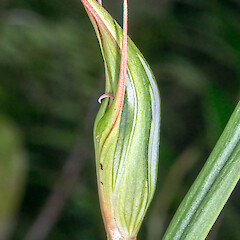Pterostylis cardiostigma
Synonyms
None (first described in 1983)
Family
Orchidaceae
Flora category
Vascular – Native
Endemic taxon
Yes
Endemic genus
No
Endemic family
No
Structural class
Orchids
NVS code
The National Vegetation Survey (NVS) Databank is a physical archive and electronic databank containing records of over 94,000 vegetation survey plots - including data from over 19,000 permanent plots. NVS maintains a standard set of species code abbreviations that correspond to standard scientific plant names from the Ngä Tipu o Aotearoa - New Zealand Plants database.
PTECAR
Chromosome number
2n = 44
Current conservation status
The conservation status of all known New Zealand vascular plant taxa at the rank of species and below were reassessed in 2017 using the New Zealand Threat Classification System (NZTCS) – more information about this can be found on the NZTCS website. This report includes a statistical summary and brief notes on changes since 2012 and replaces all previous NZTCS lists for vascular plants.
Please note, threat classifications are often suggested by authors when publications fall between NZTCS assessment periods – an interim threat classification status has not been assessed by the NZTCS panel.
- Conservation status of New Zealand indigenous vascular plants, 2017 . 2018. Peter J. de Lange, Jeremy R. Rolfe, John W. Barkla, Shannel P. Courtney, Paul D. Champion, Leon R. Perrie, Sarah M. Beadel, Kerry A. Ford, Ilse Breitwieser, Ines Schönberger, Rowan Hindmarsh-Walls, Peter B. Heenan and Kate Ladley. Department of Conservation. Source: NZTCS and licensed by DOC for reuse under the Creative Commons Attribution 4.0 International licence.
2017 | Not Threatened
Previous conservation statuses
2012 | Not Threatened
2009 | Not Threatened
2004 | Not Threatened
Distribution
Endemic. New Zealand: North Island, South Island.
Habitat
Coastal to montane. In indigenous or exotic forests and shrubland. Found in similar habitats to that frequented by P. banksii (with which it often grows). This species usually occurs as single plants or as widely spaced colonies of 4–6 plants.
Detailed description
Stout, terrestrial, tuberous, leafy, spring to summer-green perennial herb. Plant at flowering up to 400 mm tall. Tuber usually 1–(2), heart-shaped supporting 4–5 thick lateral roots. Stem stout, thick, dark green or pinkish-green, basal portion covered by 3–4 pink to carmine sheathing bracts; internodes short. Leaves all cauline, 5–7, sessile, usually strictly upright, uppermost overtopping galea; lamina 80–280 × 10–20 mm, dark green, linear-lanceolate, acuminate; midrib prominent, red, slightly to deeply grooved above, 2–(3) lateral yellow veins present either side, keel prominent, usually red. Flowers solitary, mostly green finely striped with white, apices usually pinkish or red, erect, tall and very narrow. Dorsal sepal up to 70 mm long, vertical in lower half, upper half steeply inclined rarely horizontal, apex acuminate, dark red. Lateral sepals overtopping galea, narrowly spreading, with long filiform, red caudae. Petals 60–65 mm long, marginal strip long and exposed, apices red; galea width at petal apex 6 mm. Labellum narrow, long, triangular, arching in upper ⅓, apex acuminate; distal half red with pale retrorse hairs on the upper surface and a dark red dorsal median ridge becoming paler near base; undersides with red median groove. Column shorter than labellum, stigma prominent, cordate, Ovary erect 10-30 mm tall.
Manaaki Whenua Online Interactive Key
Similar taxa
The stout growth habit, reddish stems, leaves; deeply ribbed erect leaves overtopping the flower, and the single erect, scarcely opened, tall and narrow green finely white striped, pinkish flower are distinctive of this species. If the flower is prised open the distinctive rather prominent, heart-shaped stigma is especially diagnostic. This species is most often confused with Pterostylis banksii with which it often grows, and with which it is usually confused, appearing rather deceptively as a plant with an emergent, as yet unopened flower.
Flowering
October–December
Flower colours
Green, White
Fruiting
December–March
Propagation technique
Difficult—should not be removed from the wild. Basic orchid mix consists of 2 parts medium coarse sand, ideally clean river sand; 2 parts soil, humus or leaf-mould; 1 part weathered sawdust or rotting wood; 1 part granulated bark. For Pterostylis shade of 50% and pots kept evenly moist.
Etymology
pterostylis: Winged column
Where To Buy
Not commercially available
Attribution
Fact Sheet prepared for NZPCN by P.J. de Lange 14 April 2007: Description modified from Cooper (1983).
References and further reading
Cooper DA. 1983. Pterostylis cardiostigma—a new species of Orchidaceae from Wellington, New Zealand. New Zealand Journal of Botany 21(1): 97–100. https://www.tandfonline.com/doi/abs/10.1080/0028825X.1983.10428528.
Hatch ED. 1990. Pterostylis cardiostigma D.Cooper a new record for the Waitakeres. Auckland Botanical Society Journal 45: 18.
Young M. 1991. The northward march of Pterostylis cardiostigma D.Cooper. Auckland Botanical Society Journal 46: 22–24.
NZPCN Fact Sheet citation
Please cite as: de Lange, P.J. (Year at time of access): Pterostylis cardiostigma Fact Sheet (content continuously updated). New Zealand Plant Conservation Network. https://www.nzpcn.org.nz/flora/species/pterostylis-cardiostigma/ (Date website was queried)








